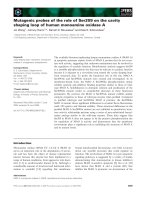Role of rehab on PPC prevention
Bạn đang xem bản rút gọn của tài liệu. Xem và tải ngay bản đầy đủ của tài liệu tại đây (14.78 MB, 27 trang )
www.bvdaihoc.com.vn
ROLES OF REHABILITATION
ON THE PREVENTION OF
POSTOPERATIVE PULMONARY COMPLICATIONS
BS. Nguyễn Đức Thành
Khoa Phục hồi chức năng
Definition
Postoperative pulmonary
complication (PPC)
• Pulmonary abnormality occur during
postoperative period
• Result in clinically significant disease
or dysfunction
Dewi Nurul Makhabah, Multidisciplinary Respiratory Medicine , Peri-operative
physiotherapy, 2013
Incidence
Postoperative pulmonary
complication (PPC)
• Range from <1% to 23%
• More common than cardiac
complications
• Most common PPC: postoperative
respiratory failure
Dewi Nurul Makhabah, Multidisciplinary Respiratory Medicine , Peri-operative
physiotherapy, 2013
Common PPCs
• Respiratory
infection
• Respiratory failure
• Pleural effusion
• Pneumothorax
• Atelectasis
• Tracheobronchitis
• Bronchospasm
• Aspiration
pneumonitis
• Pneumonia
• ARDS
• Pulmonary
embolus
• Prolonged
mechanical
ventilation
Jammer I et al. Standards for definitions and use of outcome measures for clinical effectiveness research in perioperative
medicine,. Eur J Anaesthesiol 2015
Impact
PPC
• Major cause of morbidity and
mortality
• Prolong hospital stay
• Increase cost of health care
A. Miskovic and A. B. Lumb, Postoperative pulmonary complications, British Journal of Anaesthesia,
118 (3): 317–34 (2017)
Impact
Mortality
• Increase in both short and long term
• 14–30% patients with PPC die within
30 days compared to 0.2–3% without
PPC
• 90 day mortality: significantly
increased in those with PPC (24.4 vs
1.2%)
• Mortality rates with and without
PPCs: 45.9 vs 8.7% at 1 yr, 71.4 vs
41.1% at 5 yr
A. Miskovic and A. B. Lumb, Postoperative pulmonary complications, British Journal of Anaesthesia,
118 (3): 317–34 (2017)
Impact
Morbidity and health care cost
• Increase in morbidity and length of
hospital stay (LOS)
• LOS prolonged by 13–17 days
• Increase health-care costs: primarily as a
result of increased LOS
• For example, pneumonia or respiratory failure
in a Canadian hospital —> 41 and 47%
increase in cost, respectively
A. Miskovic and A. B. Lumb, Postoperative pulmonary complications, British Journal of Anaesthesia,
118 (3): 317–34 (2017)
Risk factors of PPC
•
•
•
•
•
Advanced age
Smoking
Malnutrition
Obesity
Lung and other
chronic diseases
(liver, heart)
• Preoperative SpO2
<96%
• Preoperative anaemia
100 g/dl
• Intrathoracic/upper
abdominal surgery
• Laparotomy >
laparoscopy
• Duration of surgery >2 h
• Emergency surgery
• Effects of anesthetic
drugs on respiratory
system
A. Miskovic and A. B. Lumb, Postoperative pulmonary
complications, British Journal of Anaesthesia, 118 (3): 317–
34 (2017)
Mechanism of PPCs
• Decrease in lung volumes and
capacities
• Abnormal respiratory pattern
• Abnormal gas exchange
• Pulmonary defense in patients
undergoing surgery: start with
anesthetic induction and perpetuate
in postop period
Souza Possa, Portuguese journal of pulmonology,
Implementation of a guideline for physical therapy in the
postoperative period of upper abdominal surgery reduces the
incidence of atelectasis and length of hospital stay, 2014
Mechanism of PPCs
Diaphragmatic
dysfunction caused by
• Trauma from
manipulation close to
the diaphragm
• Reflex inhibition of
afferent abdominal
receptors
• Postoperative pain
Souza Possa, Portuguese journal of pulmonology, Implementation of a guideline for physical therapy in the postoperative
period of upper abdominal surgery reduces the incidence of atelectasis and length of hospital stay, 2014
Strategies to reduce
PPC
•
•
•
•
•
Monitor and reduce risk factors
Improve preoperative status
Patient education
Smoking cessation
Pre-operative, intra-operative and
post-operative pulmonary care
Dewi Nurul Makhabah, Multidisciplinary Respiratory Medicine , Peri-operative
physiotherapy, 2013
Strategies to reduce
PPC
Roles of rehabilitation
•
•
•
•
•
Prevent and treat PPCs
Reduce prevalence of difficult weaning
Decrease length of ICU stay
Shorten patient’s recovery period
Improve QoL, health status and general
conditions
Dewi Nurul Makhabah, Multidisciplinary Respiratory
Medicine , Peri-operative physiotherapy, 2013
Roles of rehabilitation
Pulmonary PT
• Thoracic expansion exercises
• Diaphragmatic breathing exercises
• Incentive spirometry
• Continuous positive airway pressure
(CPAP) —> improve oxygenation
without triggering increase in pain or
other complications, lower frequency
PPCs
Roles of rehabilitation
Early mobilization and muscle
training
• Prevent PPCs
• Improve functional outcomes,
cognitive and respiratory conditions
• Reduce risk of DVT
• Reduce need of painkillers
• Avoid neuromuscular complications
• Enhance recovery
Dewi Nurul Makhabah, Multidisciplinary Respiratory
Medicine , Peri-operative physiotherapy, 2013
Roles of rehabilitation
Neuromuscular electrical
stimulation
• Induce changes in muscle function without
any form of ventilatory stress
• Easily performed in ICU, applied to thigh
muscles
Dewi Nurul Makhabah, Multidisciplinary Respiratory
Medicine , Peri-operative physiotherapy, 2013
Evidences
Evidences
Evidences
Evidences
Evidences
Evidences
Evidences
Evidences
Evidences









